Predicting the Mechanical Properties of Bimrocks with High Rock Block Proportions Based on Resonance Testing Technology and Damage Theory
Abstract
1. Introduction
2. Specimen Preparation and Experimental Method
3. Analysis of Resonance Test Results
4. Analysis of the Uniaxial Compression Test Results
5. Damage Constitutive Model
6. Fast Discrimination Method of Bimrocks Physical Properties
6.1. Relationship between the Dynamic Elastic Modulus and Mechanical Parameters
- (1)
- In the process of reducing the RBP from 90% to 80%, the matrix filled most of the gaps between rocks. In the interim, the compactness of the specimens increased, which led to a corresponding rapid increase in the dynamic elastic modulus. However, the strength of the welded bimrocks was still mainly dependent on the bond strength of the soil rock interface in this case. Thus, the UCS did not increase significantly.
- (2)
- With a further reduction in the RBP, the compaction degree of the specimens continued to increase. Meanwhile, the dynamic elastic modulus grew steadily. As shown in Figure 11, the UCS underwent a relatively significant change, even though the dynamic elastic modulus varied slightly. Thus, we infer that the dominant influencing factor of the UCS gradually changed from the interface strength to the matrix ratio and strength in this period.
6.2. Relationship between the Dynamic Elastic Modulus and Calibration Parameters
7. Conclusions
Author Contributions
Funding
Conflicts of Interest
References
- Xu, W.; Hu, R.; Tan, R.; Zeng, R.; Yu, H. Study on field test of rock-soil aggregate on right bank of Longpan in tiger-leaping gorge area. Chin. J. Rock Mech. Eng. 2006, 25, 1270–1277. [Google Scholar]
- Xu, W.J.; Hu, R.L. Some geomechanical properties of soil–rock mixtures in the Hutiao Gorge area, China. Geotech 2007, 3, 255–264. [Google Scholar] [CrossRef]
- Li, X.; Liao, Q.L.; He, J.M.; Chen, J. Study on in-situ tests of mechanical characteristics on soil-rock aggregate. Chin. J. Rock Mech. Eng. 2007, 26, 2377–2384. [Google Scholar]
- Xu, W.J.; Wang, S. Meso-mechanics of soil-rock mixture with real shape of rock blocks based on 3D. Chin. J. Rock Mech. Eng. 2016, 35, 2152–2160. (In Chinese) [Google Scholar]
- Coli, N.; Berry, P.; Boldini, D. In situ non-conventional shear tests for the mechanical characterisation of a bimrock. Int. J. Rock Mech. Min. Sci. 2011, 48, 95–102. [Google Scholar] [CrossRef]
- Yue, Z.Q.; Chen, S.; Tham, L.G. Finite element modeling of geomaterials using digital image processing. Comput. Geotech. 2003, 30, 375–397. [Google Scholar] [CrossRef]
- Xu, W.J.; Yue, Z.Q.; Hu, R.L. Study on the mesostructure and mesomechanical characteristics of the soil–rock mixture using digital image processing based finite element method. Int. J. Rock Mech. Min. Sci. 2008, 45, 749–762. [Google Scholar] [CrossRef]
- Ding, X.; Li, Y.; Wang, X. Particle flow modeling mechanical properties of soil and rock mixtures based on digital image. Chin. J. Rock Mech. Eng. 2010, 29, 477–484. (In Chinese) [Google Scholar]
- Yue, Z. Digital representation of mesogeomaterial spatial distribution and associated numerical analysis of geomechanics: Methods, applications and development. Chin. J. Rock Mech. Eng. 2006, 25, 875–888. (In Chinese) [Google Scholar]
- Qiu, P.; Hu, R.; Hu, L.; Liu, Q.; Xing, Y.; Yang, H.; Qi, J.; Ptak, T. A Numerical Study on Travel Time Based Hydraulic Tomography Using the SIRT Algorithm with Cimmino Iteration. Water 2019, 11, 909. [Google Scholar] [CrossRef]
- Taherdangkoo, R.; Taherdangkoo, M. Modified stem cells algorithm-based neural network applied to bottom hole circulating pressure in underbalanced drilling. Int. J. Pet. Eng. 2015, 1, 178–188. [Google Scholar] [CrossRef]
- Afifipour, M.; Moarefvand, P. Mechanical behavior of bimrocks having high rock block proportion. Int. J. Rock Mech. Min. Sci. 2014, 65, 40–48. [Google Scholar] [CrossRef]
- Afifipour, M.; Moarefvand, P. Experimental study of post-peak behavior of bimrocks with high rock block proportions. J. Central South Univ. 2014, 21, 761–767. [Google Scholar] [CrossRef]
- Sonmez, H.; Ercanoglu, M.; Kalender, A.; Dagdelenler, G.; Tunusluoglu, C. Predicting uniaxial compressive strength and deformation modulus of volcanic bimrock considering engineering dimension. Int. J. Rock Mech. Min. Sci. 2016, 86, 91–103. [Google Scholar] [CrossRef]
- Kalender, A.; Sonmez, H.; Medley, E.; Tunusluoglu, C.; Kasapoglu, K.E. An approach to predicting the overall strengths of unwelded bimrocks and bimsoils. Eng. Geol. 2014, 183, 65–79. [Google Scholar] [CrossRef]
- Lindquist, E.S. The Strength and Deformation Properties of Melange. Ph.D. Thesis, Department of Civil Engineering, University of California, Berkeley, CA, USA, 1994. [Google Scholar]
- Altinsoy, H. A Physical Based Model Investigation for Determination of Shear Strength of Block in Matrix Rocks. Master’s Thesis, Geological Engineering Department, Hacettepe University, Ankara, Turkey, 2006. [Google Scholar]
- Coskun, A. Development of an Empirical Approach to Overcome the Problems foBoundary Condition between Bimrocks and Jointed Rock Masses. Master’s Thesis, Geological Engineering Department, Hacettepe University, Ankara, Turkey, 2010. [Google Scholar]
- Mahdevari, S.; Maarefvand, P. Applying ultrasonic waves to evaluate the volumetric block proportion of bimrocks. Arab. J. Geosci. 2017, 10, 204. [Google Scholar] [CrossRef]
- Slatalla, N.; Alber, M.; Kahraman, S. Analyses of acoustic emission response of a fault breccia in uniaxial deformation. Bull. Eng. Geol. Environ. 2010, 69, 455–463. [Google Scholar] [CrossRef]
- Wang, Y.; Li, X. Experimental study on cracking damage characteristics of a soil and rock mixture by UPV testing. Bull. Eng. Geol. Environ. 2015, 74, 775–788. [Google Scholar] [CrossRef]
- Wang, Y.; Li, X.; Hu, R.L.; Li, S.D.; Wang, J.Y. Experimental study of the ultrasonic and mechanical properties of SRM under compressive loading. Environ. Earth Sci. 2015, 74, 5023–5037. [Google Scholar] [CrossRef]
- Sun, H.F.; Xing, M.X.; Yang, Y.M.; Ju, Y. Damage characterization and analysis of SRM during uniaxial compression. In Proceedings of the 3rd International-Society-for-Rock-Mechanics (ISRM) SINOROCK Symposium, Shanghai, China, 18–20 June 2013; pp. 219–224. [Google Scholar]
- Wang, Y.; Li, C.H.; Hu, Y.Z. Use of X-ray computed tomography to investigate the effect of rock blocks on meso-structural changes in soil-rock mixture under triaxial deformation. Constr. Build. Mater. 2018, 164, 386–399. [Google Scholar] [CrossRef]
- Medley, E.W. The Engineering Characterization of meLanges and Similar Block-in-Matrix Rocks (bimrocks). Ph.D. Thesis, University of California, Berkeley, CA, USA, 1994. [Google Scholar]
- Medley, E. Orderly Characterization of Chaotic Franciscan melanges. Eng. Geol. 2001, 4, 20–32. [Google Scholar]
- Nanjiing Water Conservancy Science Research Institute. Soil Test Technical Manuals; China Communication Press: Beijing, China, 2004; pp. 17–73. (In Chinese) [Google Scholar]
- British Standard. Methods of Test for Soils for Civil Engineering Purposes—Part 1: General Requirements and Sample Preparation, BS1377-1; British Standard Institution: London, UK, 1990. [Google Scholar]
- Operator’s Manual for E-Meter MK Ⅱ Resonance Frequency Tester; James Instruments incorporated company: Chicago, IL, USA, 2013; pp. 24–25.
- Bieniawski, Z.T. Rock Mechanics Design in Mining and Tunneling; A.A. Balkema Publications: Rotterdam, The Netherlands, 1984; p. 271. [Google Scholar]
- Chaboche, J.L. Continuum damage mechanics—A tool to describe phenomena before crack initiation. Nucl. Eng. Des. 1981, 64, 233–247. [Google Scholar] [CrossRef]
- Lemaitre, J.; Chaboche, J.L. Mechanics of Solid Materials; Cambridge University Press: Cambridge, UK, 1990. [Google Scholar]
- Dougill, J.W. On stable progressively fraxturing solid. J. Appl. Math. Phys. 1967, 27, 432–437. [Google Scholar]
- Lemaitre, J. How to use damage mechanics. Nucl. Eng. Des. 1984, 80, 233–245. [Google Scholar] [CrossRef]
- Richard, B.; Ragueneau, F.; Cremona, C.; Adelaide, L. Isotropic continuum damage mechanics for concrete under cyclic loading: Stiffness recovery, inelastic strains and frictional sliding. Eng. Fract. Mech. 2010, 77, 1203–1223. [Google Scholar] [CrossRef]
- Liu, N.; Peng, L.; Shi, C.; Lei, M. Experimental and model study on dynamic behaviour and fatigue damage of tunnel invert. Constr. Build. Mater. 2016, 126, 777–784. [Google Scholar] [CrossRef]
- Ma, J.; Zhao, G.; Khalili, N. A fully coupled flow deformation model for elasto-plastic damage analysis in saturated fractured porous media. Int. J. Plast. 2016, 76, 29–50. [Google Scholar] [CrossRef]
- Ma, J.; Zhao, G.; Khalili, N. An elastoplastic damage model for fractured porous media. Mech. Mater. 2016, 100, 41–54. [Google Scholar] [CrossRef]
- Ma, J.; Wang, J. A Stress-Induced Permeability Evolution Model for Fissured Porous Media. Rock Mech. Rock Eng. 2016, 49, 477–485. [Google Scholar] [CrossRef]
- Reckwerth, D.; Tsakmakis, C. The principle of generalized energy equivalence in continuum damage mechancis. In Deformation and Failure in Metallic Materials; Springer: Berlin/Heidelberg, Germany, 2003; pp. 381–406. [Google Scholar]
- Voyiadjis, G.Z.; Kattan, P.I. A generalized hypothesis of elastic energy equivalence in continuum damage mechanics. Eng. Trans. 2017, 65, 351–369. [Google Scholar]
- Hustrulid, W.A.; Bullock, R.L. Underground Mining Methods: Engineering Fundamentals and International Case Studies; Society for Mining, Metallurgy, and Exploration, Inc. (SME): Littleton, CO, USA, 2001. [Google Scholar]
- Benzaazoua, M.; Fall, M.; Belen, T. A contribution to understanding the hardening process of cemented pastefill. Miner. Eng. 2004, 17, 141–152. [Google Scholar] [CrossRef]
- Afifipour, M.; Moarefvand, P. Failure patterns of geomaterials with block-in-matrix texture: Experimental and numerical evaluation. Arab. J. Geosci. 2014, 7, 2781–2792. [Google Scholar] [CrossRef]
- Fairhurst, C.E.; Hudson, J.A. Draft ISRM suggested method for the complete stress-strain curve for intact rock in uniaxial compression. Int. J. Rock Mech. Mining Sci. 1999, 36, 279–289. [Google Scholar]
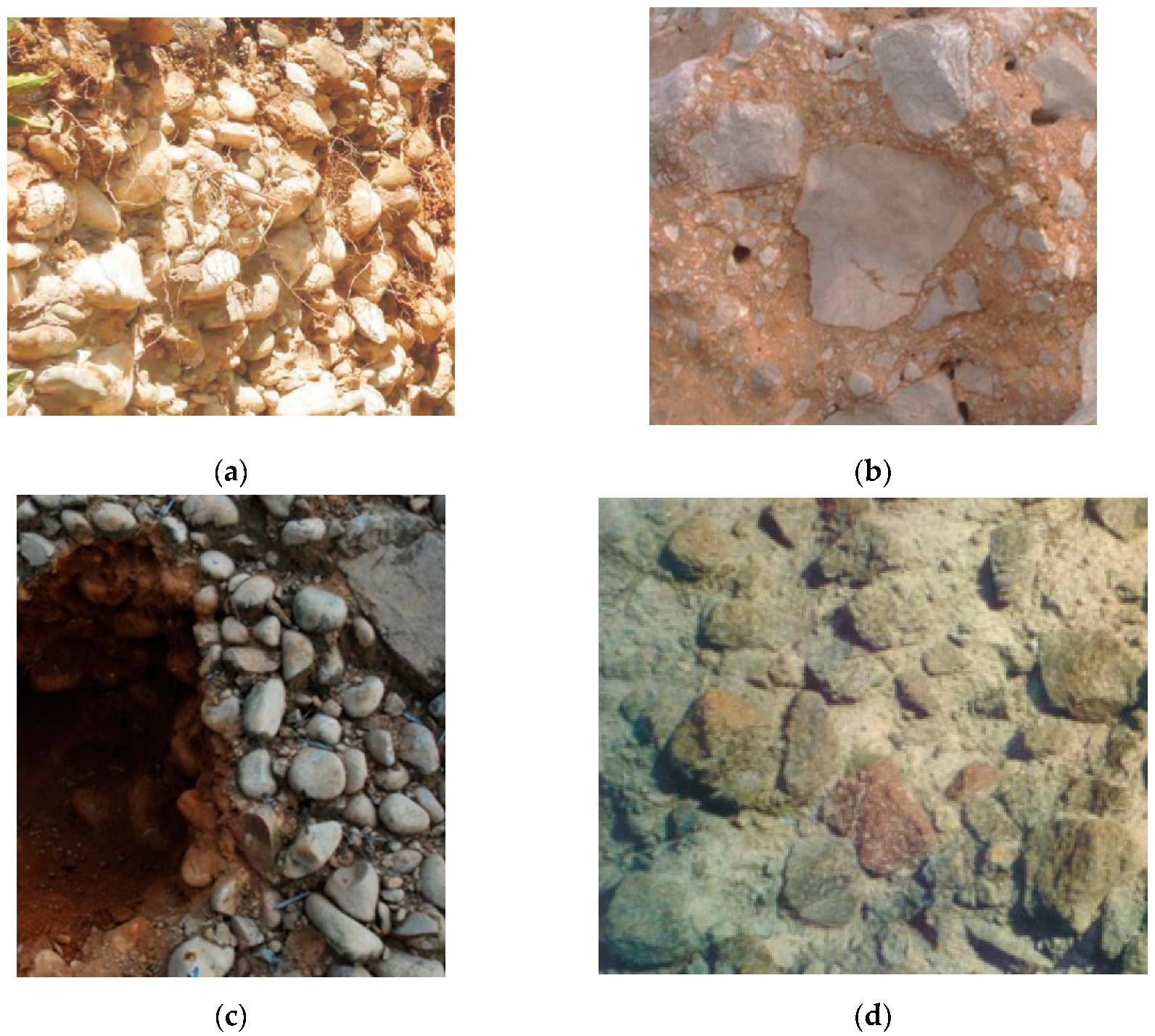
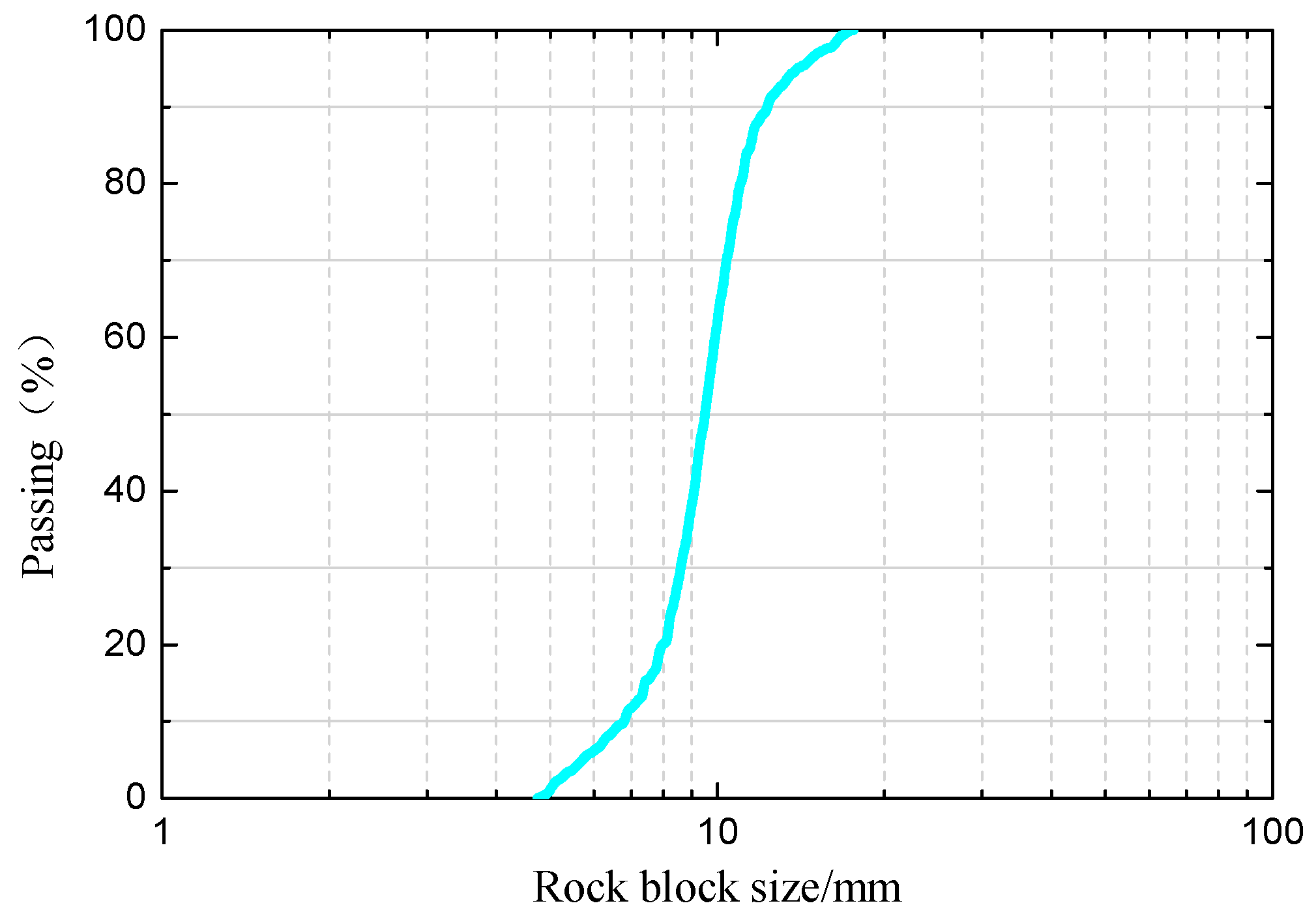
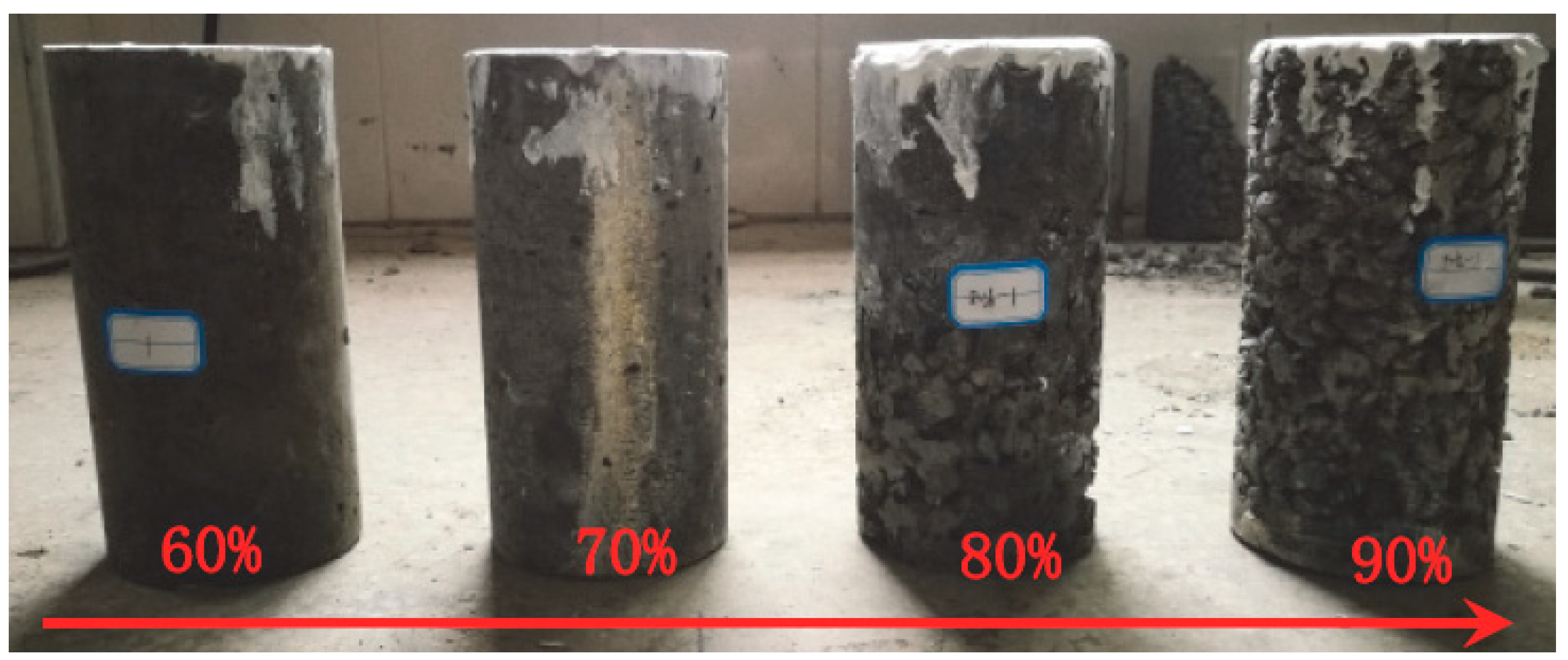
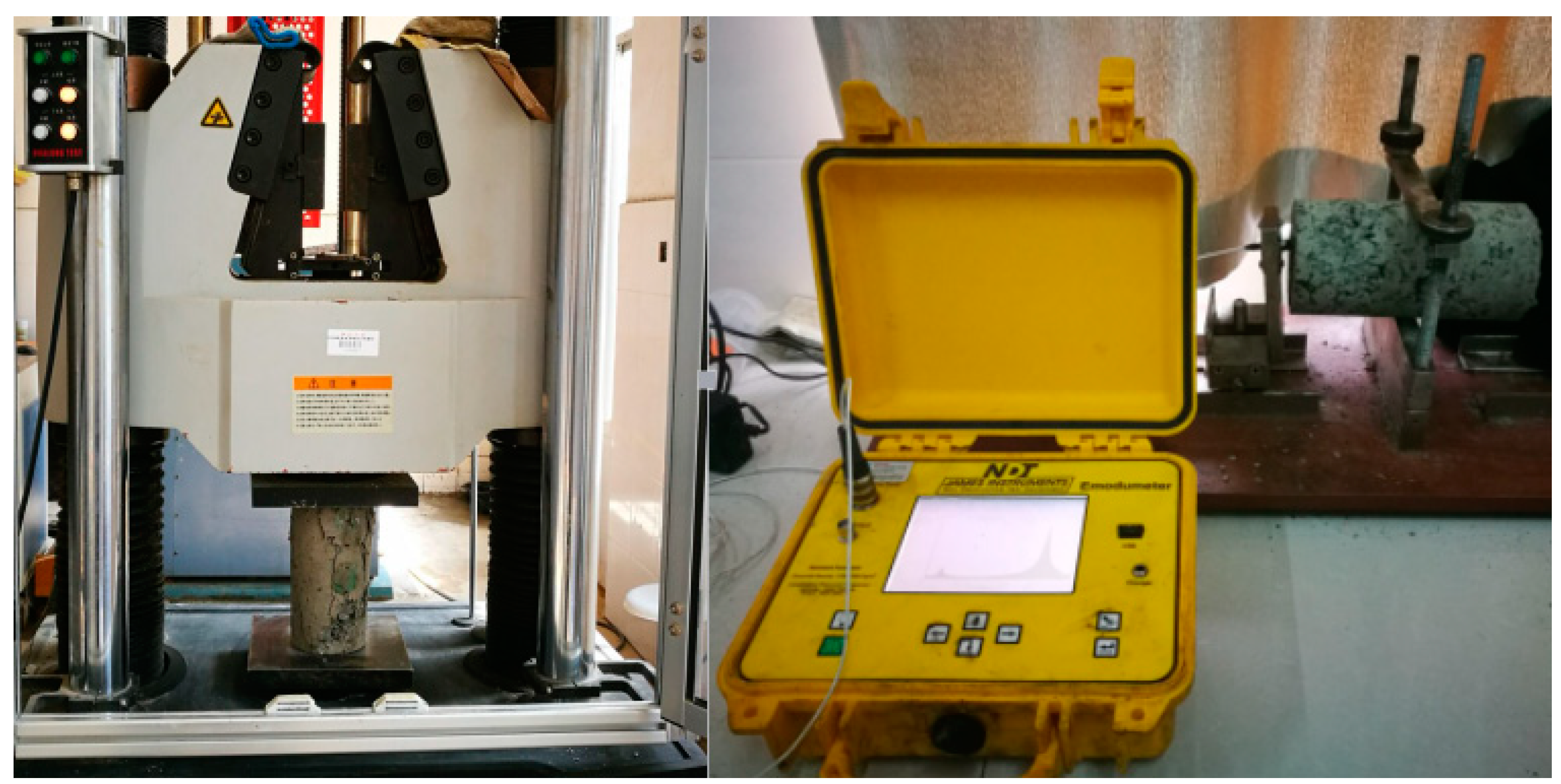
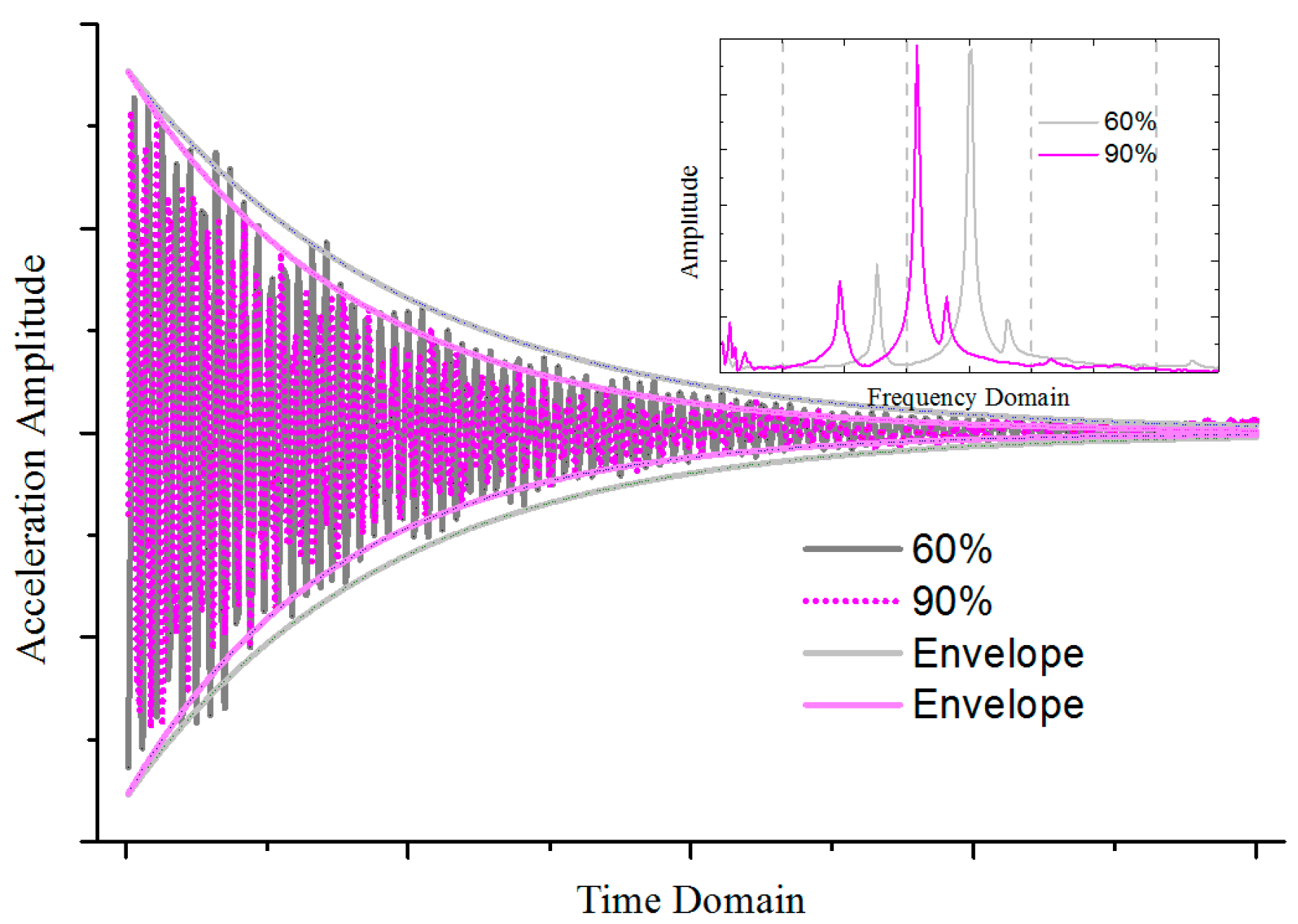
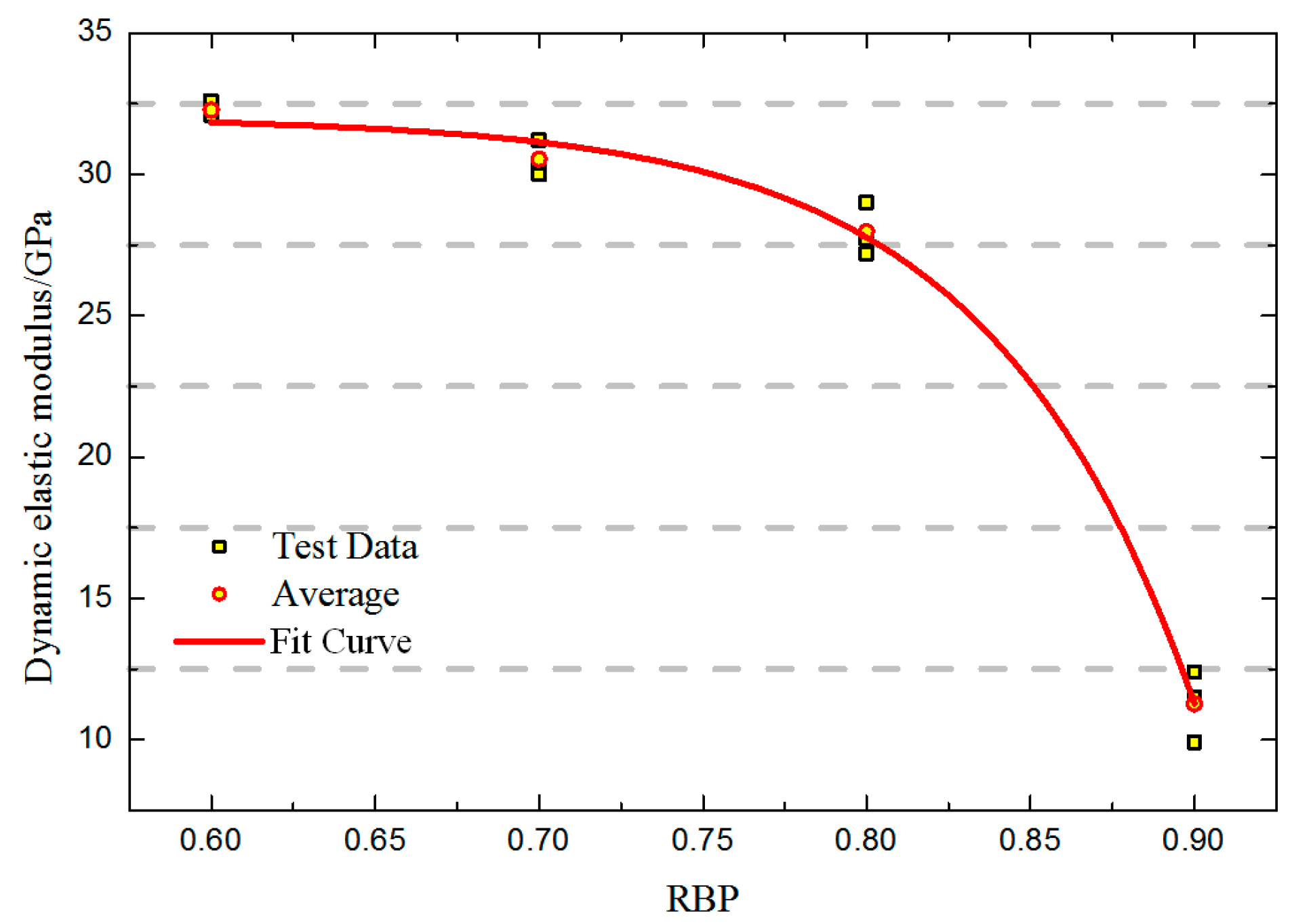

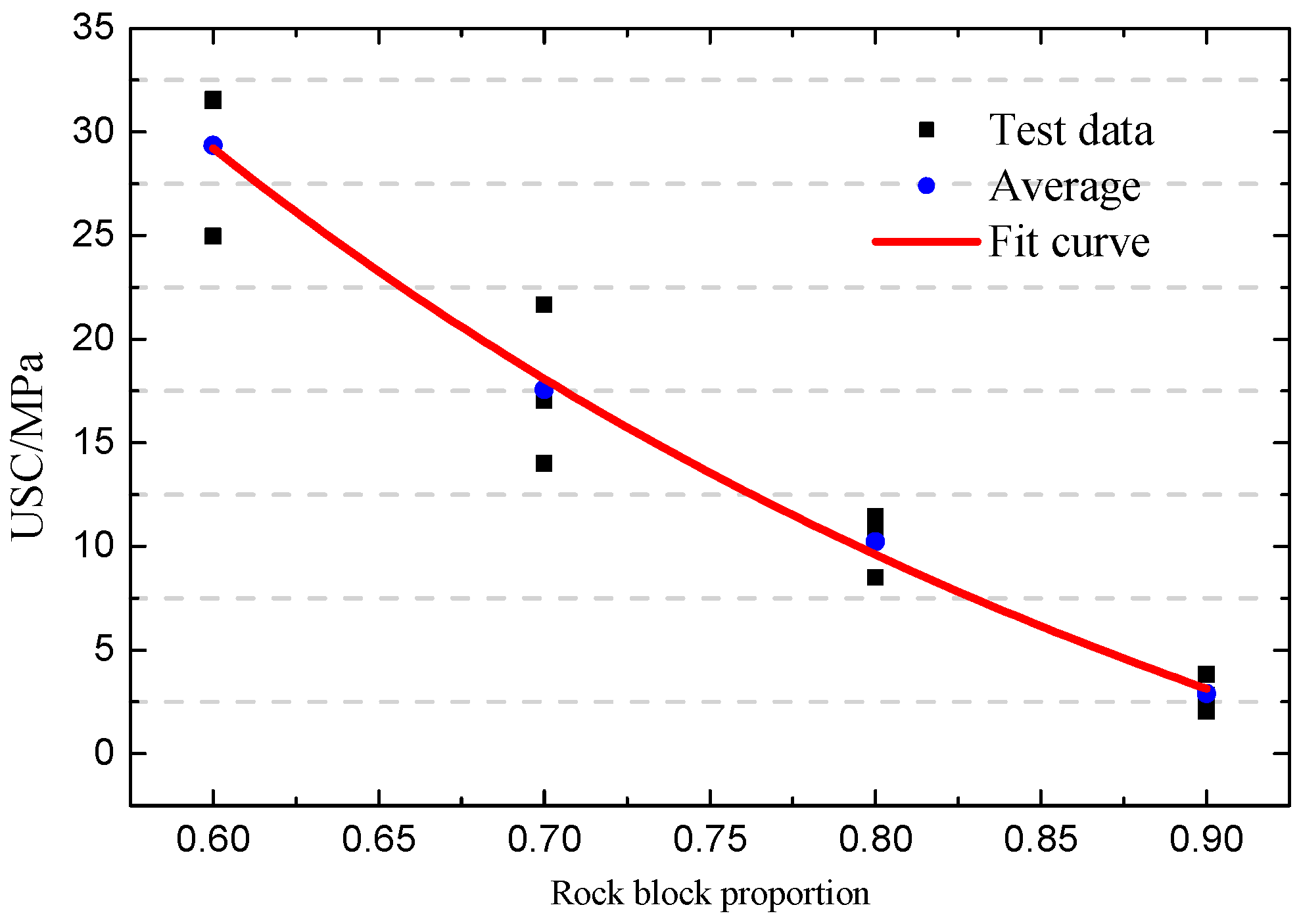
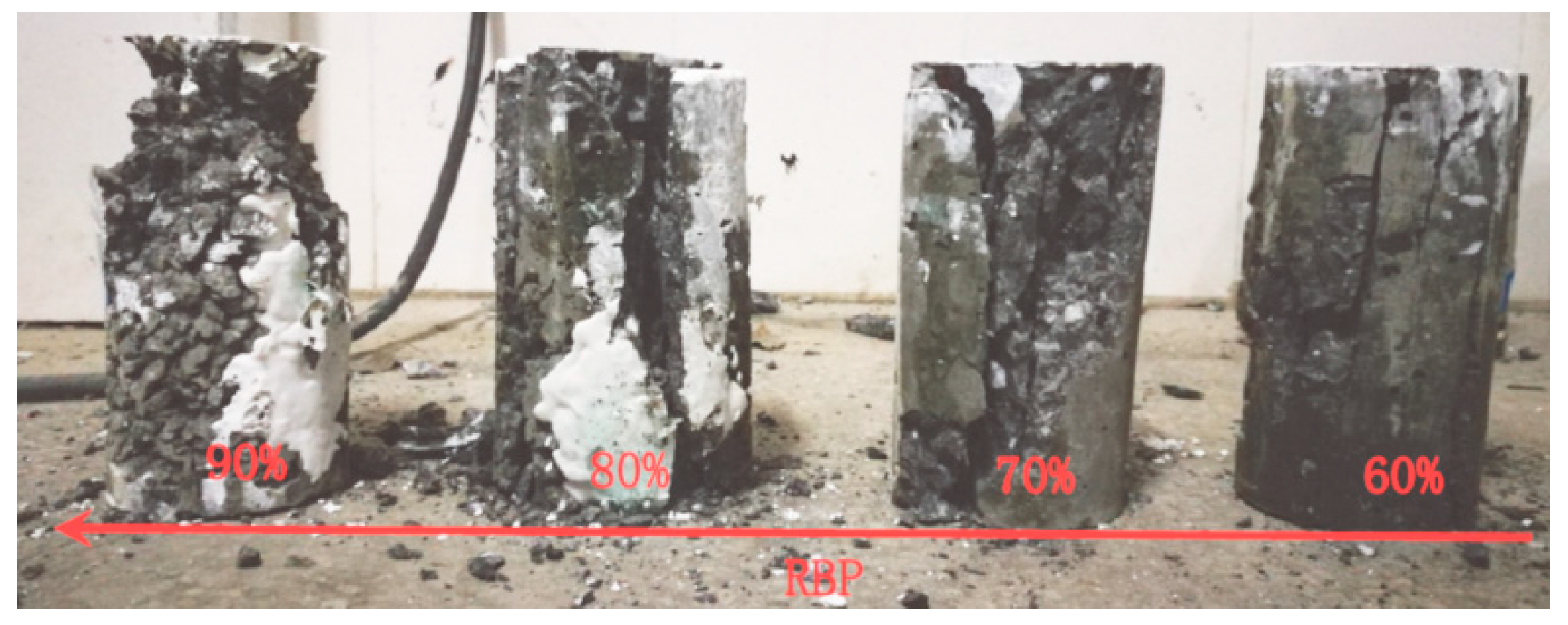
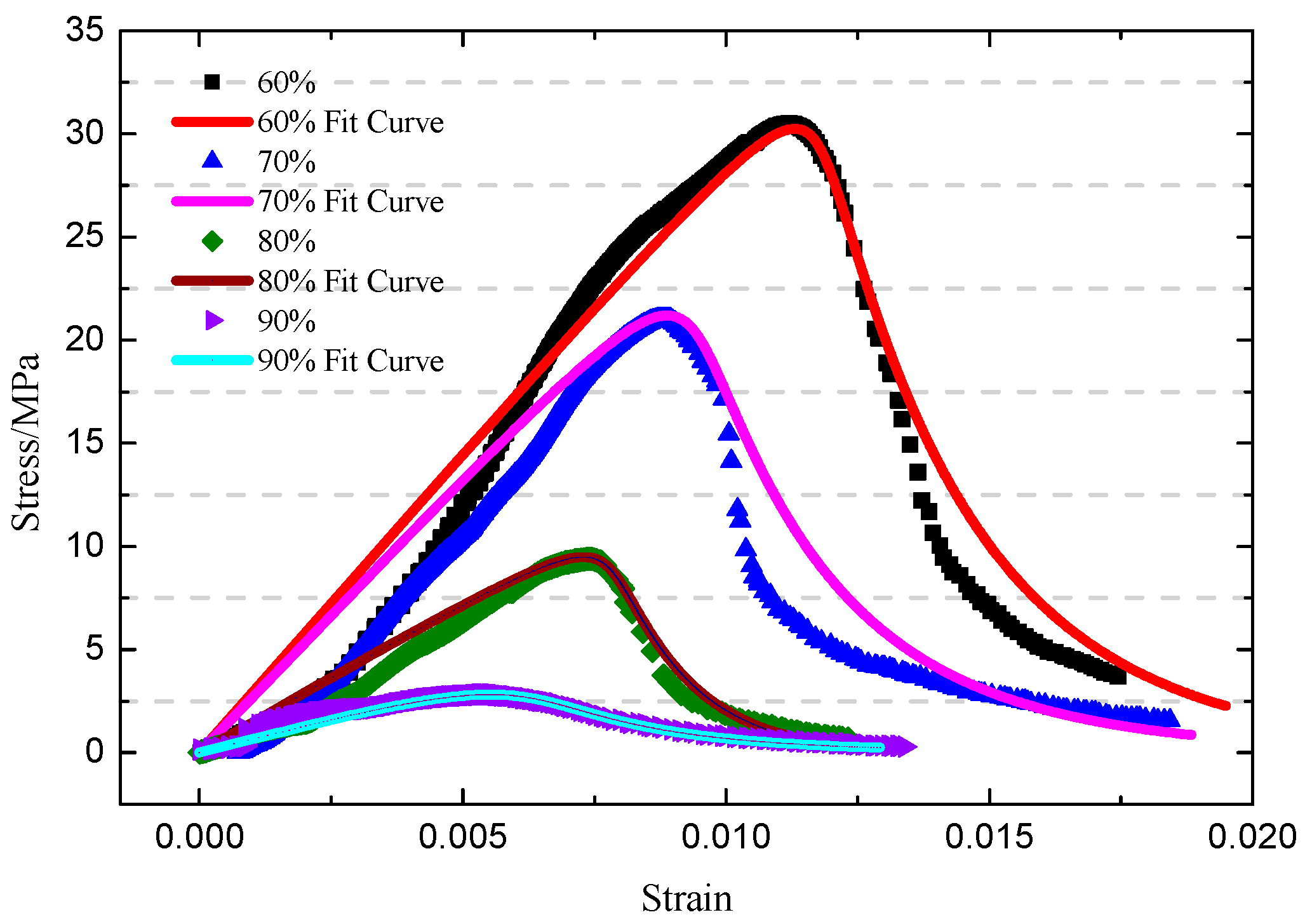
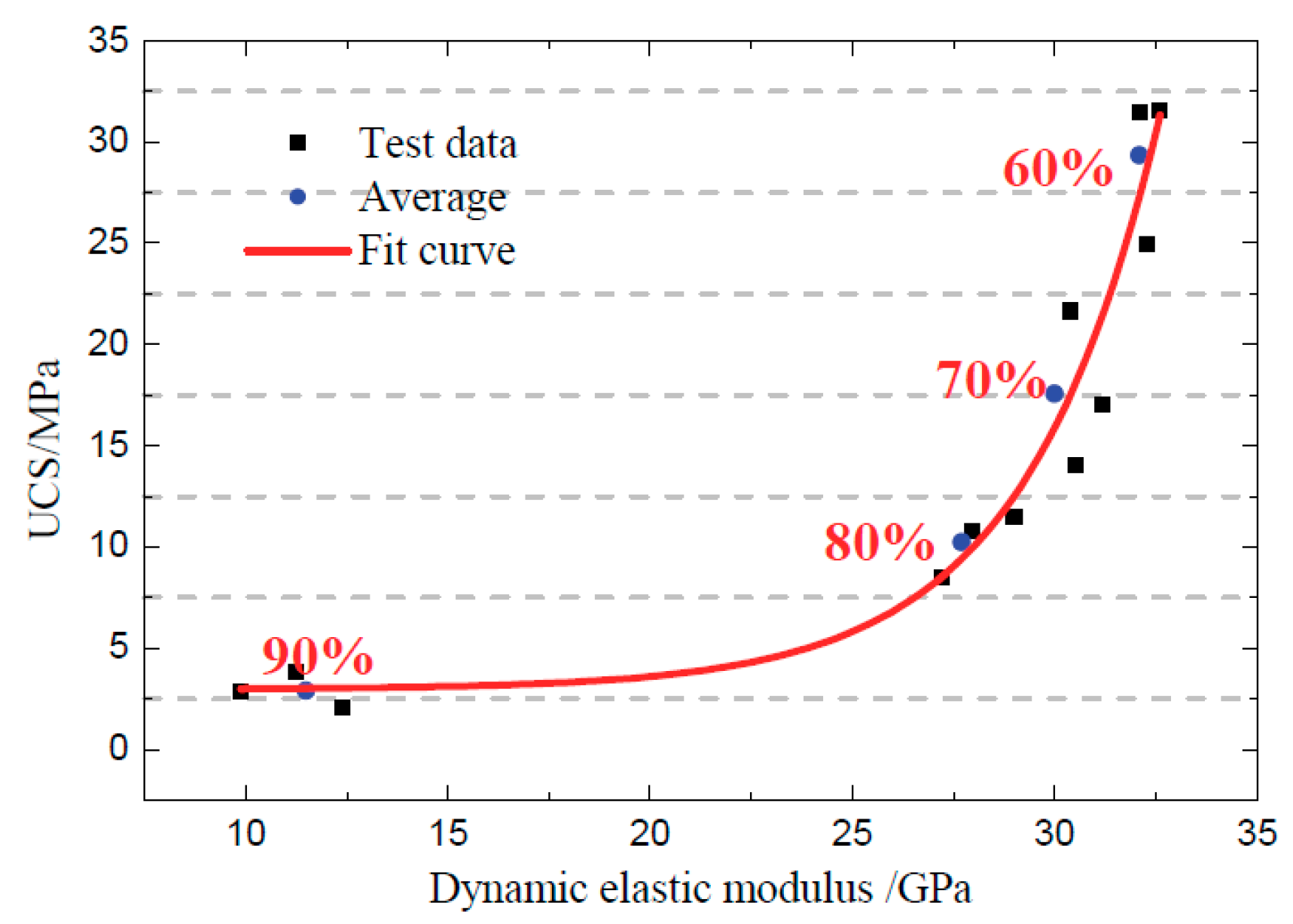


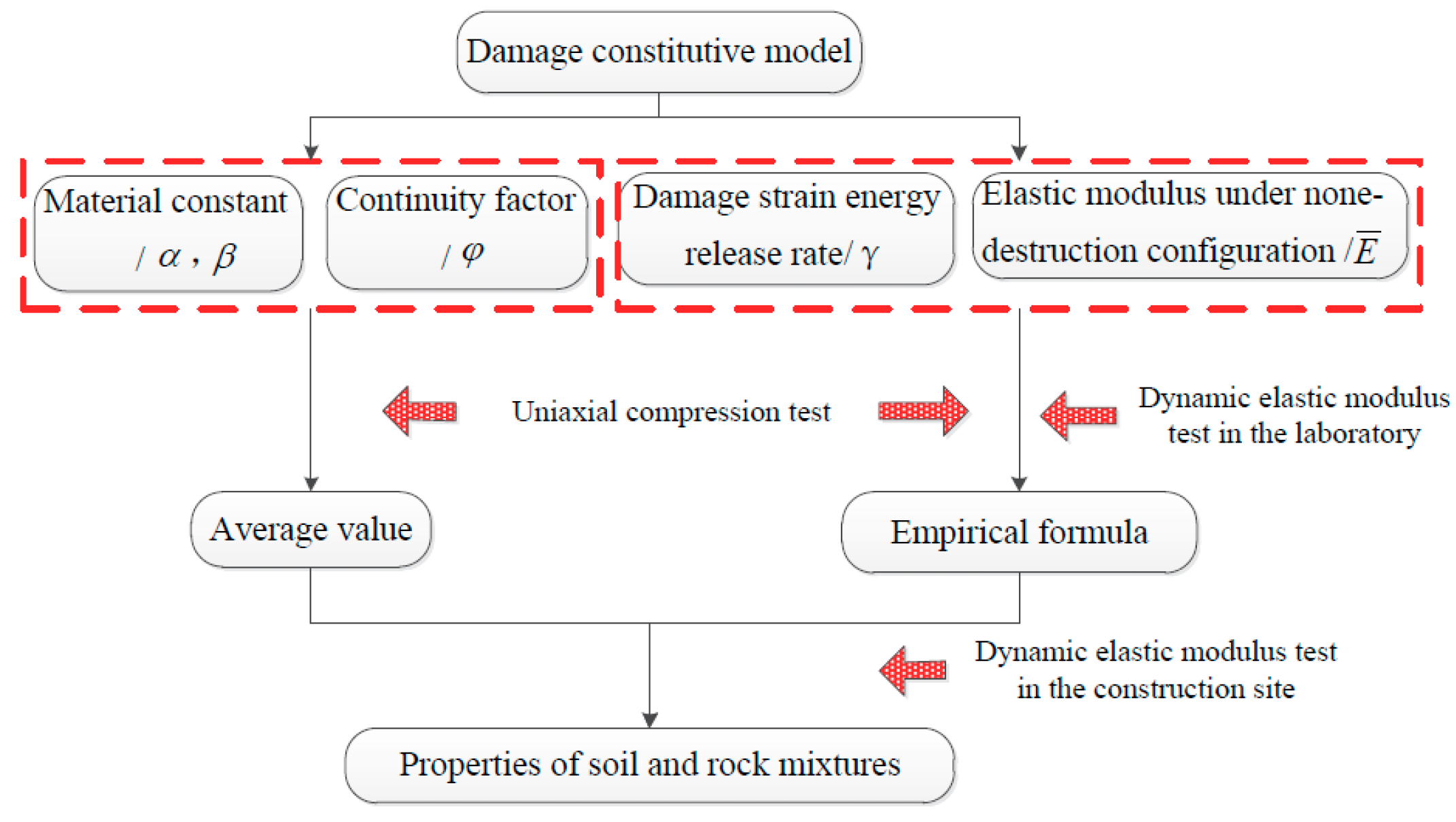
| RBP | Specimen-1 | Specimen-2 | Specimen-3 | Average |
|---|---|---|---|---|
| 60% | 31.49 | 31.58 | 24.97 | 29.35 |
| 70% | 21.65 | 17.04 | 14.01 | 17.57 |
| 80% | 8.49 | 11.46 | 10.74 | 10.23 |
| 90% | 2.82 | 2.04 | 3.82 | 2.89 |
| RBP | /kPa | /GPa | R2 (post peak zone) | ||||
|---|---|---|---|---|---|---|---|
| 60% | 0.97 | 215.76 | 3.24 | 0.26 | 0.54 | 0.90 | 3.88 |
| 70% | 0.95 | 118.81 | 2.92 | 0.28 | 0.57 | 0.85 | 3.19 |
| 80% | 0.91 | 46.98 | 1.53 | 0.30 | 0.58 | 0.94 | 1.68 |
| 90% | 0.85 | 15.42 | 0.79 | 0.33 | 0.60 | 0.97 | 0.93 |
© 2019 by the authors. Licensee MDPI, Basel, Switzerland. This article is an open access article distributed under the terms and conditions of the Creative Commons Attribution (CC BY) license (http://creativecommons.org/licenses/by/4.0/).
Share and Cite
Lin, Y.; Peng, L.; Lei, M.; Wang, X.; Cao, C. Predicting the Mechanical Properties of Bimrocks with High Rock Block Proportions Based on Resonance Testing Technology and Damage Theory. Appl. Sci. 2019, 9, 3537. https://doi.org/10.3390/app9173537
Lin Y, Peng L, Lei M, Wang X, Cao C. Predicting the Mechanical Properties of Bimrocks with High Rock Block Proportions Based on Resonance Testing Technology and Damage Theory. Applied Sciences. 2019; 9(17):3537. https://doi.org/10.3390/app9173537
Chicago/Turabian StyleLin, Yuexiang, Limin Peng, Mingfeng Lei, Xiang Wang, and Chengyong Cao. 2019. "Predicting the Mechanical Properties of Bimrocks with High Rock Block Proportions Based on Resonance Testing Technology and Damage Theory" Applied Sciences 9, no. 17: 3537. https://doi.org/10.3390/app9173537
APA StyleLin, Y., Peng, L., Lei, M., Wang, X., & Cao, C. (2019). Predicting the Mechanical Properties of Bimrocks with High Rock Block Proportions Based on Resonance Testing Technology and Damage Theory. Applied Sciences, 9(17), 3537. https://doi.org/10.3390/app9173537







